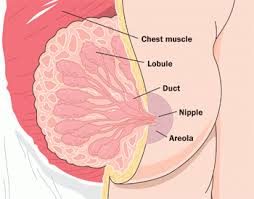Breast cancer
Breast cancer is a common type of invasive cancer that is a leading cause of mortality in women.Advances in screening and treatment have improved survival rates dramatically since 1989. There are around 3.1 million breast cancer survivors in the United States (U.S.). The chance of any woman dying from breast cancer is around 1 in 37, or 2.7 percent. Breast cancer can be:
Ductal carcinoma: This begins in the milk duct and is the most common type.
Lobular carcinoma: This starts in the lobules.Symptoms
The first symptoms of breast cancer are usually an area of thickened tissue in the breast, or a lump in the breast or in an armpit.
symptoms include:
a pain in the armpits or breast that does not change with the monthly cycle
pitting or redness of the skin of the breast, like the skin of an orange
a rash around or on one of the nipples
a discharge from a nipple, possibly containing blood
a sunken or inverted nipple
a change in the size or shape of the breast. risk factors include
Genetics
If a close relative has or has had, breast cancer, the risk is higher.
Women who carry the BRCA1 and BRCA2 genes have a higher risk of developing breast cancer, ovarian cancer or both. These genes can be inherited. TP53 is another gene that is linked to a greater breast cancer risk.a history of breast carcinoma or breast lump is also indicative
Oestrogen:It has been seen that incidence of breast carcinoma has been closely linked to increased production of oestrogen.in periods and late menopause can lead to increased oestrogen therefore these women have cancer.Body weight: women who are obese and are gaining body weight are at high risk of havinh breast carcinoma.Diagnosis
A diagnosis often occurs as the result of routine screening, or when a woman approaches her doctor after detecting symptoms.
Some diagnostic tests and procedures help to confirm a diagnosis.
Breast exam:Doctors usually examine for a dense breast tissue or a breast lump.also it is noted that whether there is any positive history of breast cancer in the family. mammogram:a type of x-ray commonly used for initial breast cancer screening. It produces images that can help detect any lumps or abnormalities.
A suspicious result can be followed up by further diagnosis. However, mammography sometimes shows up a suspicious area that is not cancer. This can lead to unnecessary stress and sometimes interventions.Diagnosis also involves staging the cancer, to establish:
the size of a tumor
how far it has spread
whether it is invasive or non-invasive
whether it has metastasized, or spread to other parts of the body.Treatment will depend on:the type of breast cancer
the stage of the cancer
sensitivity to hormones
the patient's age, overall health, and preferences
The main options include:
radiation therapy
surgery
biological therapy,.jpg)